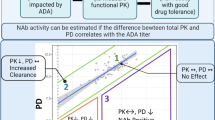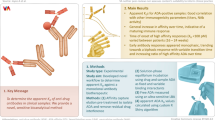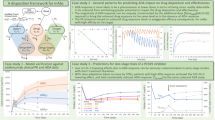Abstract
The availability of highly sensitive immunoassays enables the detection of antidrug antibody (ADA) responses of various concentrations and affinities. The analysis of the impact of antibody status on drug pharmacokinetics (PK) is confounded by the presence of low-affinity or low-concentration antibody responses within the dataset. In a phase 2 clinical trial, a large proportion of subjects (45%) developed ADA following weekly dosing with AMG 317, a fully human monoclonal antibody therapeutic. The antibody responses displayed a wide range of relative concentrations (30 ng/mL to >13 μg/mL) and peaked at various times during the study. To evaluate the impact of immunogenicity on PK, AMG 317 concentration data were analyzed following stratification by dose group, time point, antibody status (positive or negative), and antibody level (relative concentration). With dose group as a stratifying variable, a moderate reduction in AMG 317 levels (<50%) was observed in antibody-positive subjects when compared to antibody-negative subjects, but the difference was not statistically significant in all dose groups. The most significant reduction in AMG 317 levels was revealed when antibody data was stratified by both time point and antibody level. In general, high ADA concentrations (>500 ng/mL) and later time points (week 12) were associated with significantly (up to 97%) lower trough AMG 317 concentrations. The use of quasi-quantitative antibody data and appropriate statistical methods was critical for the most comprehensive evaluation of the impact of immunogenicity on PK.






Similar content being viewed by others
REFERENCES
Shankar G, Pendley C, Stein KE. A risk-based bioanalytical strategy for the assessment of antibody immune responses against biological drugs. Nat Biotechnol. 2007;25(5):555–61.
Schellekens H. Factors influencing the immunogenicity of therapeutic proteins. Nephrol Dial Transplant. 2005;20 Suppl 6:vi3–9.
De Groot AS, Scott DW. Immunogenicity of protein therapeutics. Trends Immunol. 2007;28(11):482–90.
Nelson AL, Dhimolea E, Reichert JM. Development trends for human monoclonal antibody therapeutics. Nat Rev Drug Discov. 2010;9(10):767–74.
Getts DR, Getts MT, McCarthy DP, Chastain EM, Miller SD. Have we overestimated the benefit of human(ized) antibodies? MAbs. 2010;2(6):682–94.
Bender NK, Heilig CE, Droll B, Wohlgemuth J, Armbruster FP, Heilig B. Immunogenicity, efficacy and adverse events of adalimumab in RA patients. Rheumatol Int. 2007;27(3):269–74.
Furie R, Stohl W, Ginzler EM, Becker M, Mishra N, Chatham W, et al. Biologic activity and safety of belimumab, a neutralizing anti-B-lymphocyte stimulator (BLyS) monoclonal antibody: a phase I trial in patients with systemic lupus erythematosus. Arthritis Res Ther. 2008;10(5):R109.
Kay J, Rahman MU. Golimumab: a novel human anti-TNF-alpha monoclonal antibody for the treatment of rheumatoid arthritis, ankylosing spondylitis, and psoriatic arthritis. Core Evid. 2010;4:159–70.
Shankar G, Shores E, Wagner C, Mire-Sluis A. Scientific and regulatory considerations on the immunogenicity of biologics. Trends Biotechnol. 2006;24(6):274–80.
Mire-Sluis AR, Barrett YC, Devanarayan V, Koren E, Liu H, Maia M, et al. Recommendations for the design and optimization of immunoassays used in the detection of host antibodies against biotechnology products. J Immunol Methods. 2004;289(1–2):1–16.
Koren E, Smith HW, Shores E, Shankar G, Finco-Kent D, Rup B, et al. Recommendations on risk-based strategies for detection and characterization of antibodies against biotechnology products. J Immunol Methods. 2008;333(1–2):1–9.
Shankar G, Devanarayan V, Amaravadi L, Barrett YC, Bowsher R, Finco-Kent D, et al. Recommendations for the validation of immunoassays used for detection of host antibodies against biotechnology products. J Pharm Biomed Anal. 2008;48(5):1267–81.
Patton A, Mullenix MC, Swanson SJ, Koren E. An acid dissociation bridging ELISA for detection of antibodies directed against therapeutic proteins in the presence of antigen. J Immunol Methods. 2005;304(1–2):189–95.
Moxness M, Tatarewicz S, Weeraratne D, Murakami N, Wullner D, Mytych D, et al. Immunogenicity testing by electrochemiluminescent detection for antibodies directed against therapeutic human monoclonal antibodies. Clin Chem. 2005;51(10):1983–5.
Lofgren JA, Dhandapani S, Pennucci JJ, Abbott CM, Mytych DT, Kaliyaperumal A, et al. Comparing ELISA and surface plasmon resonance for assessing clinical immunogenicity of panitumumab. J Immunol. 2007;178(11):7467–72.
Murphy M, Jason-Moller L, Bruno J. Using Biacore to measure the binding kinetics of an antibody–antigen interaction. Curr Protoc Protein Sci. 2006;Chapter 19:Unit 19 4.
Gorovits B. Antidrug antibody assay validation: industry survey results. AAPS J. 2009;11(1):133–8.
Corren J, Busse W, Meltzer EO, Mansfield L, Bensch G, Fahrenholz J, et al. A randomized, controlled, phase 2 study of AMG 317, an IL-4Ralpha antagonist, in patients with asthma. Am J Respir Crit Care Med. 2009;181(8):788–96.
Kakkar T, Sung C, Gibiansky L, Vu T, Narayanan A, Lin SL, et al. Population PK and IgE pharmacodynamic analysis of a fully human monoclonal antibody against IL4 receptor. Pharm Res. 2011;28(10):2530–42.
US Department of Health and Human Services, FDA (CDER, CBER). Guidance for industry—assay development for immunogenicity testing of therapeutic proteins (draft). 2009. http://www.fda.gov/downloads/Drugs/GuidanceComplianceRegulatoryInformation/Guidances/UCM192750.pdf. Accessed 1 Oct 2012.
Gibiansky L, Gibiansky E, Kakkar T, Ma P. Approximations of the target-mediated drug disposition model and identifiability of model parameters. J Pharmacokinet Pharmacodyn. 2008;35(5):573–91.
Benson G, Auerswald G, Elezovic I, Lambert T, Ljung R, Morfini M, et al. Immune tolerance induction in patients with severe hemophilia with inhibitors: expert panel views and recommendations for clinical practice. Eur J Haematol. 2012;88(5):371–9.
Rehlaender BN, Cho MJ. Antibodies as carrier proteins. Pharm Res. 1998;15(11):1652–6.
van der Laken CJ, Voskuyl AE, Roos JC, Stigtervan Walsum M, de Groot ER, Wolbink G, et al. Imaging and serum analysis of immune complex formation of radiolabelled infliximab and anti-infliximab in responders and non-responders to therapy for rheumatoid arthritis. Ann Rheum Dis. 2007;66(2):253–6.
Shmagel KV, Chereshnev VA. Molecular bases of immune complex pathology. Biochemistry (Mosc). 2009;74(5):469–79.
Tabrizi M, Bornstein GG, Suria H. Biodistribution mechanisms of therapeutic monoclonal antibodies in health and disease. AAPS J. 2010;12(1):33–43.
Lecluse LL, Driessen RJ, Spuls PI, de Jong EM, Stapel SO, van Doorn MB, et al. Extent and clinical consequences of antibody formation against adalimumab in patients with plaque psoriasis. Arch Dermatol. 2010;146(2):127–32.
Bartelds GM, Wijbrandts CA, Nurmohamed MT, Stapel S, Lems WF, Aarden L, et al. Clinical response to adalimumab: relationship to anti-adalimumab antibodies and serum adalimumab concentrations in rheumatoid arthritis. Ann Rheum Dis. 2007;66(7):921–6.
Calabresi PA, Giovannoni G, Confavreux C, Galetta SL, Havrdova E, Hutchinson M, et al. The incidence and significance of anti-natalizumab antibodies: results from AFFIRM and SENTINEL. Neurology. 2007;69(14):1391–403.
Ternant D, Aubourg A, Magdelaine-Beuzelin C, Degenne D, Watier H, Picon L, et al. Infliximab pharmacokinetics in inflammatory bowel disease patients. Ther Drug Monit. 2008;30(4):523–9.
Dirks NL, Meibohm B. Population pharmacokinetics of therapeutic monoclonal antibodies. Clin Pharmacokinet. 2010;49(10):633–59.
Xu Z, Seitz K, Fasanmade A, Ford J, Williamson P, Xu W, et al. Population pharmacokinetics of infliximab in patients with ankylosing spondylitis. J Clin Pharmacol. 2008;48(6):681–95.
Fasanmade AA, Adedokun OJ, Ford J, Hernandez D, Johanns J, Hu C, et al. Population pharmacokinetic analysis of infliximab in patients with ulcerative colitis. Eur J Clin Pharmacol. 2009;65(12):1211–28.
Zhu Y, Hu C, Lu M, Liao S, Marini JC, Yohrling J, et al. Population pharmacokinetic modeling of ustekinumab, a human monoclonal antibody targeting IL-12/23p40, in patients with moderate to severe plaque psoriasis. J Clin Pharmacol. 2009;49(2):162–75.
The common technical document for the registration of pharmaceuticals for human use. Efficacy-M4E (R1) clinical overview and clinical summary of module 2. Module 5: clinical study reports. International Conference on Harmonisation of Technical Requirements for Registration of Pharmaceuticals for Human Use; 2002.
ACKNOWLEDGMENTS
We thank Alex Colbert for coordinating the drug concentration assays and sample analysis and Mike Hale for the statistical advice. Support for the study was provided by Amgen Inc. All authors are employees and shareholders of the study sponsor.
Author information
Authors and Affiliations
Corresponding author
Additional information
Guest Editors: Bernd Meibohm and Naren Chirmule
Rights and permissions
About this article
Cite this article
Zhou, L., Hoofring, S.A., Wu, Y. et al. Stratification of Antibody-Positive Subjects by Antibody Level Reveals an Impact of Immunogenicity on Pharmacokinetics. AAPS J 15, 30–40 (2013). https://doi.org/10.1208/s12248-012-9408-8
Received:
Accepted:
Published:
Issue Date:
DOI: https://doi.org/10.1208/s12248-012-9408-8




